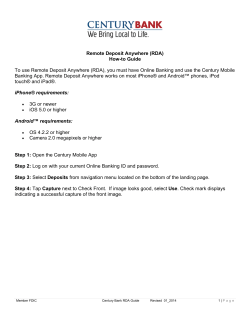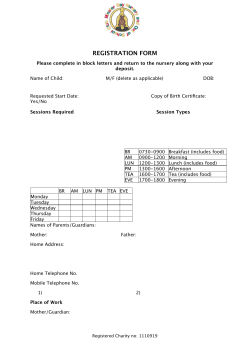
BUDGETING: FINANCIAL EDUCATION GOAL
BUDGETING: FINANCIAL EDUCATION GOAL BUDGET COMPETENCY Define and track income and expenses, using different methods; Develop a “normal” budget; Learn techniques for approaching options for handling an income shortfall or unexpected expense; Analyze the cost/benefit of different options. ! GROUP DISCUSSION: Why do we budget? WHY BUDGET? Map to reach goals; Tool for making choices; Assess what you have and what you need; Control your own financial resources; Focus on the future. WHAT DO WE BUDGET? We control our expenses, but We budget our income. Why is that important? BUDGET TARGETS & PERSONAL GOALS Identify major long-term goals; Estimate the future cost of each goal; Determine a realistic timeline to meet the goal; How much must be saved each month to reach the goal? EVERY BUDGET LINE HAS A GOAL ATTACHED. Is it necessary? How much is needed? When is it needed; how often? What quality is needed? What variables can be changed? Can it be deferred? Include all variables in your budget calculation. MAKE THE GOAL SMART. SMART Goals One way to make goals simple and clear is to make them SMART. SMART stands for: Specific—focused Measurable—you can tell if it’s been achieved Achievable—realistic Results-oriented—written about the end you are trying to get to Timebound—there is a specific time by which the goal will be reached While goals are SMART, they do NOT show how the goal will be reached. The “how” is the plan. Goals provide the destination and the direction for your plans. So, you can’t make a plan without a goal. This applies to how you get and use your money, too. A budget is just a plan for how you use your money. You can’t make a budget without having goals. MAKING YOUR GOALS WORK FOR YOU Here are the steps to figuring out the resources, time and costs to reach your goals: Step 1: Write goals. You’ve already done this! Step 2: List all of the resources you need to reach this goal. Step 3: If money is needed, estimate the amount you will need to reach the goal. If you don’t know the amount, do some research. Step 4: Figure out how many months you have to save. Count the months from now until the end time written in your goal statement. Step 5: Divide the money needed to reach goal by the months to save. This gives the amount you need to save each month. This is what you will include in your budget! DO THE MATH! Computer spreadsheet, Index cards Notebook Monthly conversions 52 weeks/12 26 bi-weekly pay periods/12 Quarterly/3 Annual/12 GROUP EXERCISE How Much to Save Each Month PRIORITIZE YOUR GOALS Don’t be limited by the present. Which goals that you achieve will help other goals? Pay yourself first! (budget your savings) Examine (record) your use of income: Share it; Save it; Spend it. WHAT ARE YOUR FINANCIAL RESOURCES? Paycheck : Fringe benefit options Taxes withheld (loan to Uncle Sam?) Credit (to increase assets or cut expenses) Employer savings match Tax credits (EITC) Asset income (rental, business use) Government and grant assistance (loans, IDA) SOURCE OF INCOME RECORDS Following is a list of different sources of income and the records you may have. Wages (full or part time job): Stub from Check; Deposit slip; Bank Account Statement Self-Employment Income: Invoices; Receipts for Payment; Deposit Slips; Bank Account Statement Bonuses: Stub from Check; Letter from Employer Stating Bonus Amount Commissions: Stub from Check; Copies of Commission Checks; Deposit Slips; Bank Account Statement Unemployment: Notice of Benefits from State Agency; Check Stub or Photocopy of Check from State Department of Labor or Economic Security Severance Payments: Letter from Employer Stating Terms; Deposit Slips; Bank Account Statement Child Support: Statement from State Disbursement Unit; Court Order (states amount of child support and schedule of payments); Deposit Records; Bank Account Statement MORE SOURCES Earned Income Tax Credit: Tax Return; Deposit Records; Bank Account Statement (if using Direct Deposit); Stub from Check if Paper Gift: Deposit Records; Bank Account Statement Public Assistance (TANF benefits): Notice of Cash Assistance from Local Department of Social Services; Stub from Check; Deposit Records; Bank Account Statement (if using Direct Deposit) Social Security Disability (SSD) and Supplemental Security Income (SSI): Notice of Benefits from Social Security Administration; Stub from Check; Deposit Records; Bank Account Statement (if using Direct Deposit) Social Security Retirement: Notice of Benefits from Social Security Administration; Stub from Check; Bank Account Statement (if using Direct Deposit) Pension: Stub from Check; Bank Account Statement (if using Direct Deposit) Social Security Survivors: Notice of Benefits; Stub from Check; Bank Account Statement (if using Direct Deposit) WHAT ARE OTHER RESOURCES? Vegetable garden Education Barter and trade Coupons Cooking and canning Stocking up on sales Making things last GROUP DISCUSSION How can expenses be grouped? (general types of goals) SIX USES OF INCOME • • • • • • Fixed Expenses Credit Card Debt Payments Occasional Expenses Savings and Sharing Goals Flexible Necessities Discretionary Wants ENVELOPE BUDGETING Developed for cash and carry economy. Divide paycheck into several envelopes for different expenses, and take from each envelope as pay that expense. Similar concept to mortgage escrow for paying taxes and insurance. Separate accounts may serve this function. How do you employ method in electronic economy? BUDGETING TOOLS & RESOURCES • • • • • Bank or Credit Union Online Independent Online System Quicken or other financial software Electronic spreadsheet (Excel) Paper Calendar or record ONLINE TOOLS • https://www.pncvirtualwallet.com/ Virtual Wallet by PNC • Allows 3 PNC accounts (spend, reserve, growth) • $25 minimum deposit • 3 check limit (promotes online transactions) • Budget calendar feature • Online bill pay • Money Bar to move between three accounts • Finance Works by Quicken (BankAtlantic) • Manage multiple accounts at different institutions • Based on Quicken software functions ONLINE TOOLS • https://www.hellowallet.com/ Hello Wallet • Independent financial planning • Budget calendar • Connect to outside accounts • Record account transactions • http://www.mvelopes.com/ Mvelopes • Add outside accounts (4) • 25 electronic envelopes • Personal coaching sessions ONLINE TOOLS • https://secure.budgettracker.com Budget Tracker • Download account information or manual entry • Manage credit cards and loans • Track income • Pay bills • Budget • Manage categories ONLINE TOOLS • https://pearbudget.com/ Pear Budget • Need not connect accounts • Simple budgeting • Monthly & irregular expenses • Budget Plan • https://www.mint.com/ Mint.Com • Connects to accounts • Categorizes expenses • Auto budgets based on history • Shows balance at any time BUDGET BOOK SPREADSHEET (EXCEL) • • • • • Cash Flow Analysis Budget by Income Period $0 Net Balance Goal Be Flexible and Adjust Budget Consider All Options SPREADSHEET EXERCISE Budget Scenario - Margaret SOLUTIONS – INCREASE INCOME. • Get another job. • Get more education or training. • Will it increase salary? • What educational debt will it create? • Start your own business. • Qualify for public benefits: • Food stamps • Subsidized housing • Free health care SOLUTIONS – CUT SPENDING. • Eliminate unnecessary expenses. • Review insurance options. • Do it your self. • Cut back on flexible expenses. • Make repairs that reduce expenses. • Look at less expensive options (e.g., different car). • Utility bill payment options. • Borrow or barter. • Plug small leaks. SOLUTIONS – COMPARISON SHOP. • Brand name – store brand – generic. • Determine if quality justifies higher cost. • Unit Price Calculation. (Use calculator)
© Copyright 2025












